In-Situ Monitoring and Control of Additive Friction Stir Deposition
Abstract
1. Introduction
2. Materials and Methods
2.1. Specimen Design, Process Planning, and Execution
2.2. Process Monitoring and Data Collection
2.2.1. Temperature Monitoring
2.2.2. Forces
2.2.3. Sound and Vibrations
2.3. Surface Topography and Residual Stresses
3. Results and Discussions
3.1. Temperature Evolution
3.2. Axial Force Measurements
3.3. Sound and Vibration Observations
3.4. Surface Characteristics and Residual Stresses
4. Conclusions
Author Contributions
Funding
Institutional Review Board Statement
Informed Consent Statement
Data Availability Statement
Conflicts of Interest
Abbreviations
| 3D | Three Dimensional |
| AFSD | Additive Friction Stir Deposition |
| AM | Additive Manufacturing |
| AMRC NW | Advanced Manufacturing Research Centre Northwest |
| CMM | Coordinate Measuring Machine |
| CNC | Computer Numerical Control |
| CSV | Comma-Separated Value |
| DED | Directed Energy Deposition |
| EXP | Experiment |
| FSAM | Friction Stir Additive Manufacturing |
| IEPE | Integrated Electronics Piezo-Electric |
| MIN | Minute |
| RPM | Rotations per Minute |
| PBF-LB | Laser-Based Powder Bed Fusion |
| PID | Proportional–Integral–Derivative |
| WEDM | Wire Electric Discharge Machining |
References
- Shao, J.; Samaei, A.; Xue, T.; Xie, X.; Guo, S.; Cao, J.; MacDonald, E.; Gan, Z. Additive Friction Stir Deposition of Metallic Materials: Process, Structure and Properties. Mater. Des. 2023, 234, 112356. [Google Scholar] [CrossRef]
- Yang, T.; Mazumder, S.; Jin, Y.; Squires, B.; Sofield, M.; Pantawane, M.V.; Dahotre, N.B.; Neogi, A. A Review of Diagnostics Methodologies for Metal Additive Manufacturing Processes and Products. Materials 2021, 14, 4929. [Google Scholar] [CrossRef] [PubMed]
- Xu, J.; Fei, Y.; Zhu, Y.; Yu, W.; Yao, D.; Zhou, J.G. A Review of Non-Powder-Bed Metal Additive Manufacturing: Techniques and Challenges. Materials 2024, 17, 4717. [Google Scholar] [CrossRef] [PubMed]
- Alifui-Segbaya, F.; Ituarte, I.F.; Hasanov, S.; Gupta, A.; Fidan, I. Opportunities and Limitations of Additive Manufacturing. In Springer Handbook of Additive Manufacturing; Pei, E., Bernard, A., Gu, D., Klahn, C., Monzón, M., Petersen, M., Sun, T., Eds.; Springer International Publishing: Cham, Switzerland, 2023; pp. 125–143. ISBN 9783031207518. [Google Scholar]
- Khodabakhshi, F.; Gerlich, A.P. Potentials and Strategies of Solid-State Additive Friction-Stir Manufacturing Technology: A Critical Review. J. Manuf. Process. 2018, 36, 77–92. [Google Scholar] [CrossRef]
- Leirmo, J.L.; Baturynska, I. Challenges and Proposed Solutions for Aluminium in Laser Powder Bed Fusion. Procedia CIRP 2020, 93, 114–119. [Google Scholar] [CrossRef]
- Yasa, E.; Poyraz, O.; Molyneux, A.; Sharman, A.; Bilgin, G.M.; Hughes, J. Systematic Review on Additive Friction Stir Deposition: Materials, Processes, Monitoring and Modelling. Inventions 2024, 9, 116. [Google Scholar] [CrossRef]
- Dong, X.; Zhou, M.; Geng, Y.; Han, Y.; Lei, Z.; Chen, G.; Shi, Q. Recent Advances in Additive Friction Stir Deposition: A Critical Review. Materials 2024, 17, 5205. [Google Scholar] [CrossRef]
- Li, X.; Li, X.; Hu, S.; Liu, Y.; Ma, D. Additive Friction Stir Deposition: A Review on Processes, Parameters, Characteristics, and Applications. Int. J. Adv. Manuf. Technol. 2024, 133, 1111–1128. [Google Scholar] [CrossRef]
- Schmitz, T.; Charles, E.; Compton, B. Analytical Temperature Model for Spindle Speed Selection in Additive Friction Stir Deposition. Manuf. Lett. 2024, 41, 720–729. [Google Scholar] [CrossRef]
- Kar, A.; Kumar, S.; Kailas, S.V. Developing Multi-Layered 3D Printed Homogenized Structure Using Solid State Deposition Method. Mater. Charact. 2023, 199, 112770. [Google Scholar] [CrossRef]
- Tan, W.; Spear, A. Multiphysics Modeling Framework to Predict Process-Microstructure-Property Relationship in Fusion-Based Metal Additive Manufacturing. Acc. Mater. Res. 2024, 5, 10–21. [Google Scholar] [CrossRef]
- Zhang, Z.; Tan, Z.J.; Li, J.Y.; Zu, Y.F.; Liu, W.W.; Sha, J.J. Experimental and numerical studies of re-stirring and re-heating effects on mechanical properties in friction stir additive manufacturing. Int. J. Adv. Manuf. Technol. 2019, 104, 767–784. [Google Scholar]
- Mendieta, L.E.U.; Poyraz, O.; Yasa, E.; Hughes, J. An Experimental and Numerical Study on the Additive Friction Stir Deposition of Al 6061. In Proceedings of the AMC Turkey 2024, Antalya, Turkiye, 25–27 April 2024. [Google Scholar]
- Gopan, V.; Leo Dev Wins, K.; Surendran, A. Innovative Potential of Additive Friction Stir Deposition among Current Laser Based Metal Additive Manufacturing Processes: A Review. CIRP J. Manuf. Sci. Technol. 2021, 32, 228–248. [Google Scholar] [CrossRef]
- Garcia, D.; Hartley, W.D.; Rauch, H.A.; Griffiths, R.J.; Wang, R.; Kong, Z.J.; Zhu, Y.; Yu, H.Z. In Situ Investigation into Temperature Evolution and Heat Generation during Additive Friction Stir Deposition: A Comparative Study of Cu and Al-Mg-Si. Addit. Manuf. 2020, 34, 101386. [Google Scholar] [CrossRef]
- Yu, H.Z.; Mishra, R.S. Additive Friction Stir Deposition: A Deformation Processing Route to Metal Additive Manufacturing. Mater. Res. Lett. 2021, 9, 71–83. [Google Scholar] [CrossRef]
- Merritt, G.R.; Williams, M.B.; Allison, P.G.; Jordon, J.B.; Rushing, T.W.; Cousin, C.A. Closed-Loop Temperature and Force Control of Additive Friction Stir Deposition. J. Manuf. Mater. Process. 2022, 6, 92. [Google Scholar] [CrossRef]
- Chaudhary, B.; Jain, N.K.; Murugesan, J.; Patel, V. Exploring temperature-controlled friction stir powder additive manufacturing process for multi-layer deposition of aluminum alloys. J. Mater. Res. Technol. 2022, 20, 260–268. [Google Scholar]
- Gharavi, F.; Matori, K.A.; Yunus, R.; Othman, N.K.; Fadaeifard, F. Corrosion Behavior of Al6061 Alloy Weldment Produced by Friction Stir Welding Process. J. Mater. Res. Technol. 2015, 4, 314–322. [Google Scholar] [CrossRef]
- Thyssenfrupp. 70075 Aluminum vs. 6061 Aluminum. Available online: https://www.thyssenkrupp-materials.co.uk/technical-knowledge-hub/7075-aluminium-vs-6061-aluminium (accessed on 10 February 2025).
- MELD. L3&K2 Installation, Maintenance and Operator Manual, 2023. MELD Manufacturing 200 Technology Drive Christiansburg, VA 24073, USA. Available online: https://www.meldmanufacturing.com/ (accessed on 10 February 2025).
- Borase, R.P.; Maghade, D.K.; Sondkar, S.Y.; Pawar, S.N. A Review of PID Control, Tuning Method and Applications. Int. J. Dynam. Control 2021, 9, 818–827. [Google Scholar] [CrossRef]
- Landers, R.G.; Barton, K.; Devasia, S.; Kurfess, T.; Pagilla, P.; Tomizuka, M. A Review of Manufacturing Process Control. J. Manuf. Sci. Eng. 2020, 142, 110814. [Google Scholar] [CrossRef]
- Kumar, S.; Kar, A. A Review of Solid-State Additive Manufacturing Processes. Trans Indian Natl. Acad. Eng. 2021, 6, 955–973. [Google Scholar] [CrossRef]
- Davis, J.R.; Semiatin, S.L.; American Society for Metals. ASM Handbook Volume 14: Forming and Forging, 9th ed.; ASM International: Geauga County, OH, USA, 1988; ISBN 0-87170-007-7. [Google Scholar]
- Sopha, S.N.S.; Nansaarng, S. Comparative Study of Forging Parameters on Microstructures and Properties Between Aluminum Alloys Al6063 and AA7075; Department of Production Technology Education King Mongkut’s University of Technology: Thonburi, Thailand, 2007; p. 126. [Google Scholar]
- Metallo, A. Emissivity Prediction for an IR Camera During Laser Welding of Aluminum. Int. J. Thermodyn. 2022, 25, 24–34. [Google Scholar] [CrossRef]
- Hosseinzadeh, F.; Kowal, J.; Bouchard, P.J. Erratum: ‘Towards Good Practice Guidelines for the Contour Method of Residual Stress Measurement’. J. Eng. 2015, 2015, 92. [Google Scholar] [CrossRef]
- Williams, M.B.; Zhu, N.; Palya, N.I.; Hoarston, J.B.; McDonnell, M.M.; Kelly, M.R.; Lalonde, A.D.; Brewer, L.N.; Jordon, J.B.; Allison, P.G. Towards Understanding the Relationships between Processing Conditions and Mechanical Performance of the Additive Friction Stir Deposition Process. Metals 2023, 13, 1663. [Google Scholar] [CrossRef]
- Stubblefield, G.G.; Fraser, K.; Phillips, B.J.; Jordon, J.B.; Allison, P.G. A Meshfree Computational Framework for the Numerical Simulation of the Solid-State Additive Manufacturing Process, Additive Friction Stir-Deposition (AFS-D). Mater. Des. 2021, 202, 109514. [Google Scholar] [CrossRef]
- Bardel, D.; Perez, M.; Nelias, D.; Deschamps, A.; Hutchinson, C.R.; Maisonnette, D.; Chaise, T.; Garnier, J.; Bourlier, F. Coupled Precipitation and Yield Strength Modelling for Non-Isothermal Treatments of a 6061 Aluminium Alloy. Acta Mater. 2014, 62, 129–140. [Google Scholar] [CrossRef]
- Ghadimi, H.; Talachian, M.; Ding, H.; Emanet, S.; Guo, S. The Effects of Layer Thickness on the Mechanical Properties of Additive Friction Stir Deposition-Fabricated Aluminum Alloy 6061 Parts. Metals 2024, 14, 101. [Google Scholar] [CrossRef]
- Perry, M.E.J.; Griffiths, R.J.; Garcia, D.; Sietins, J.M.; Zhu, Y.; Yu, H.Z. Morphological and Microstructural Investigation of the Non-Planar Interface Formed in Solid-State Metal Additive Manufacturing by Additive Friction Stir Deposition. Addit. Manuf. 2020, 35, 101293. [Google Scholar] [CrossRef]
- Yakubov, V.; Ostergaard, H.; Hughes, J.; Yasa, E.; Karpenko, M.; Proust, G.; Paradowska, A.M. Evolution of Material Properties and Residual Stress with Increasing Number of Passes in Aluminium Structure Printed via Additive Friction Stir Deposition. Materials 2024, 17, 3457. [Google Scholar] [CrossRef]
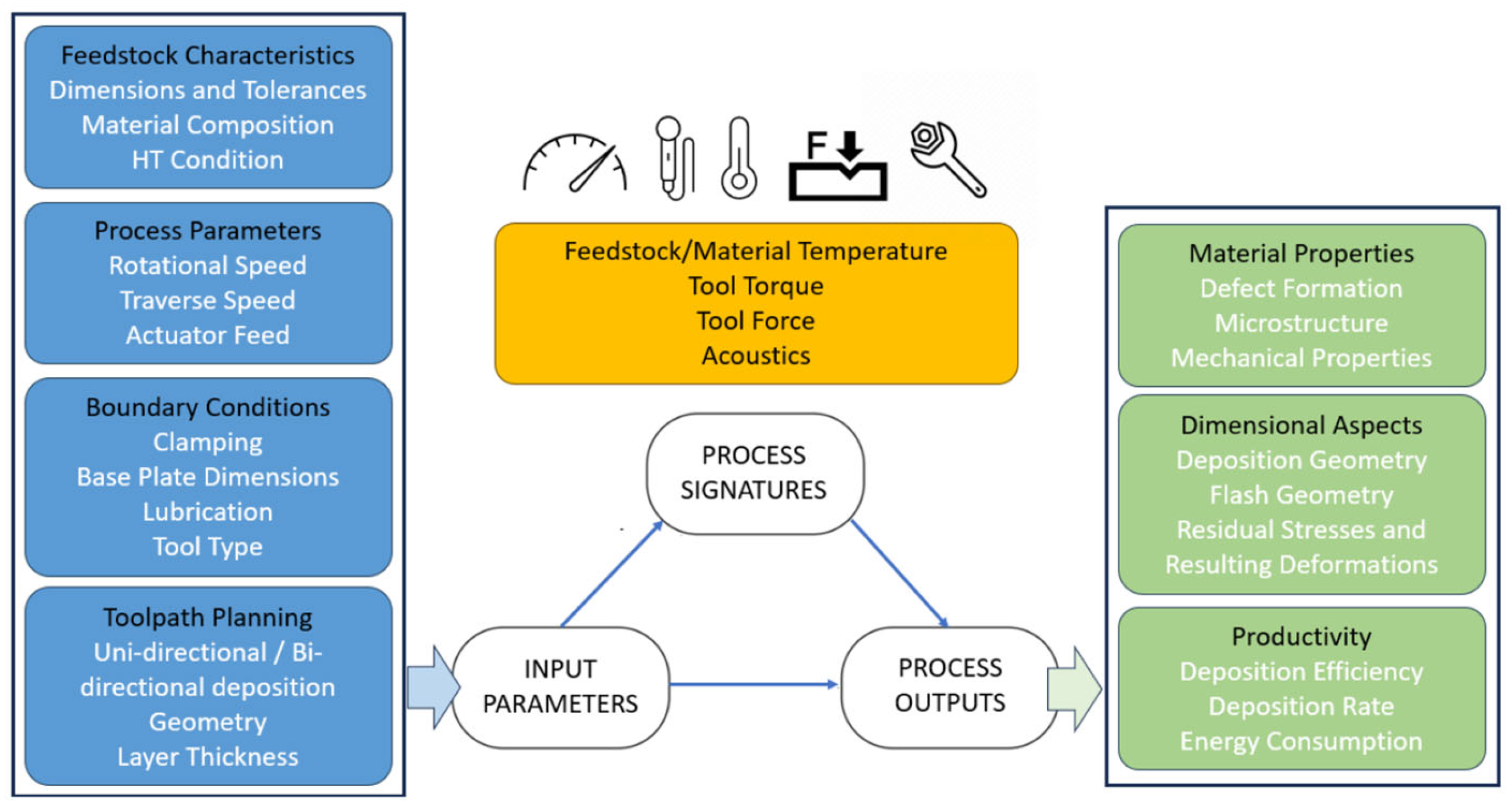

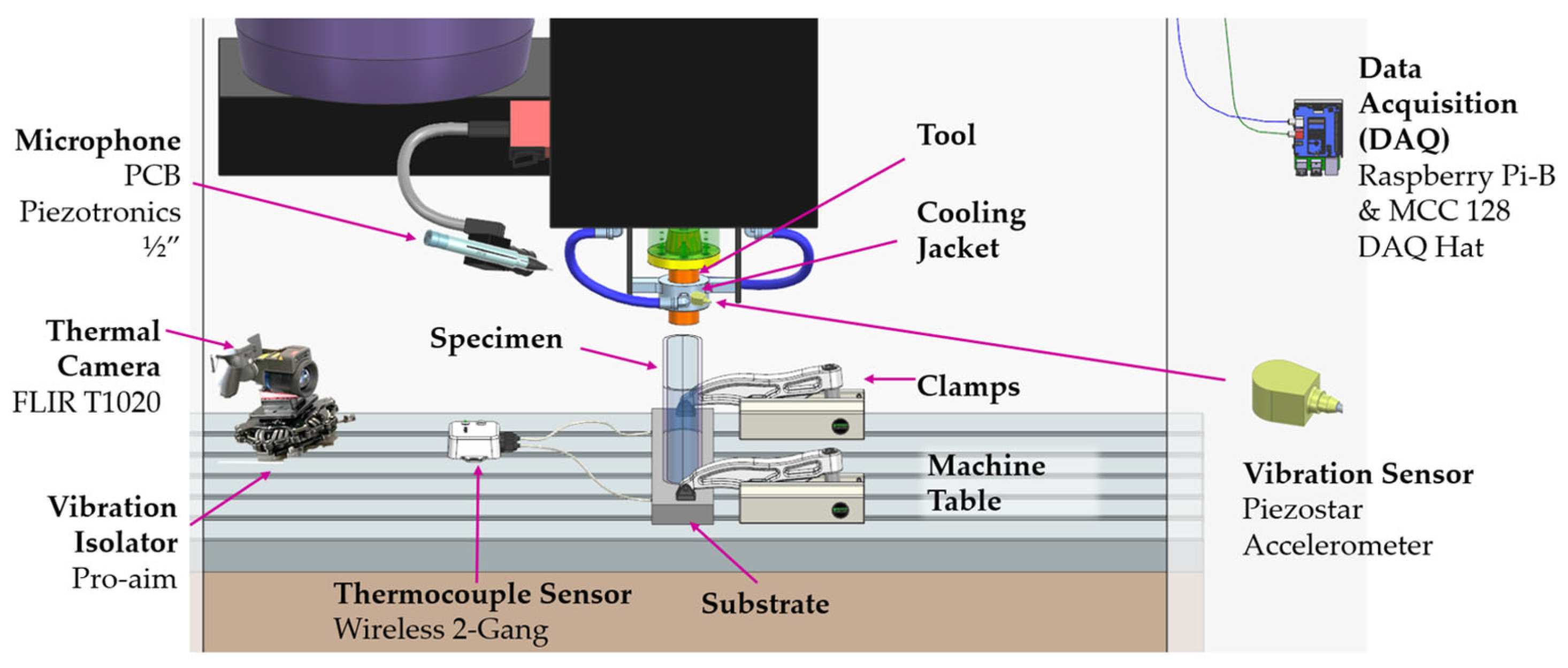


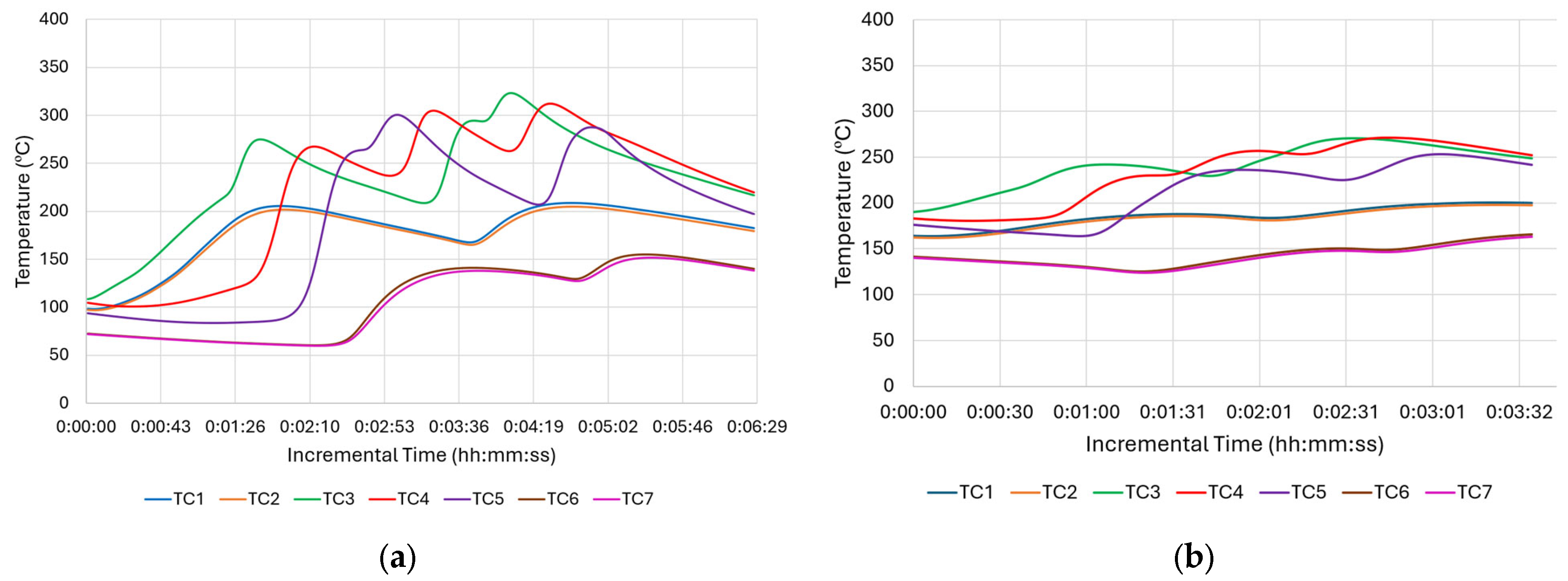
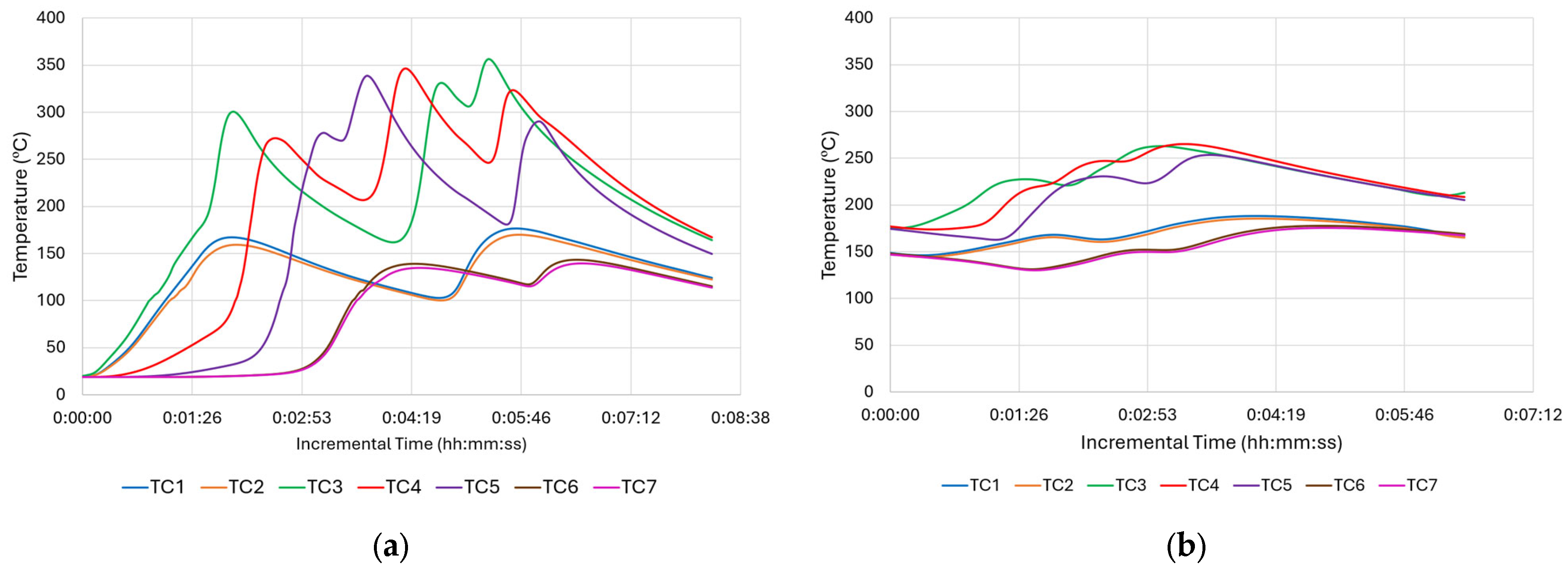
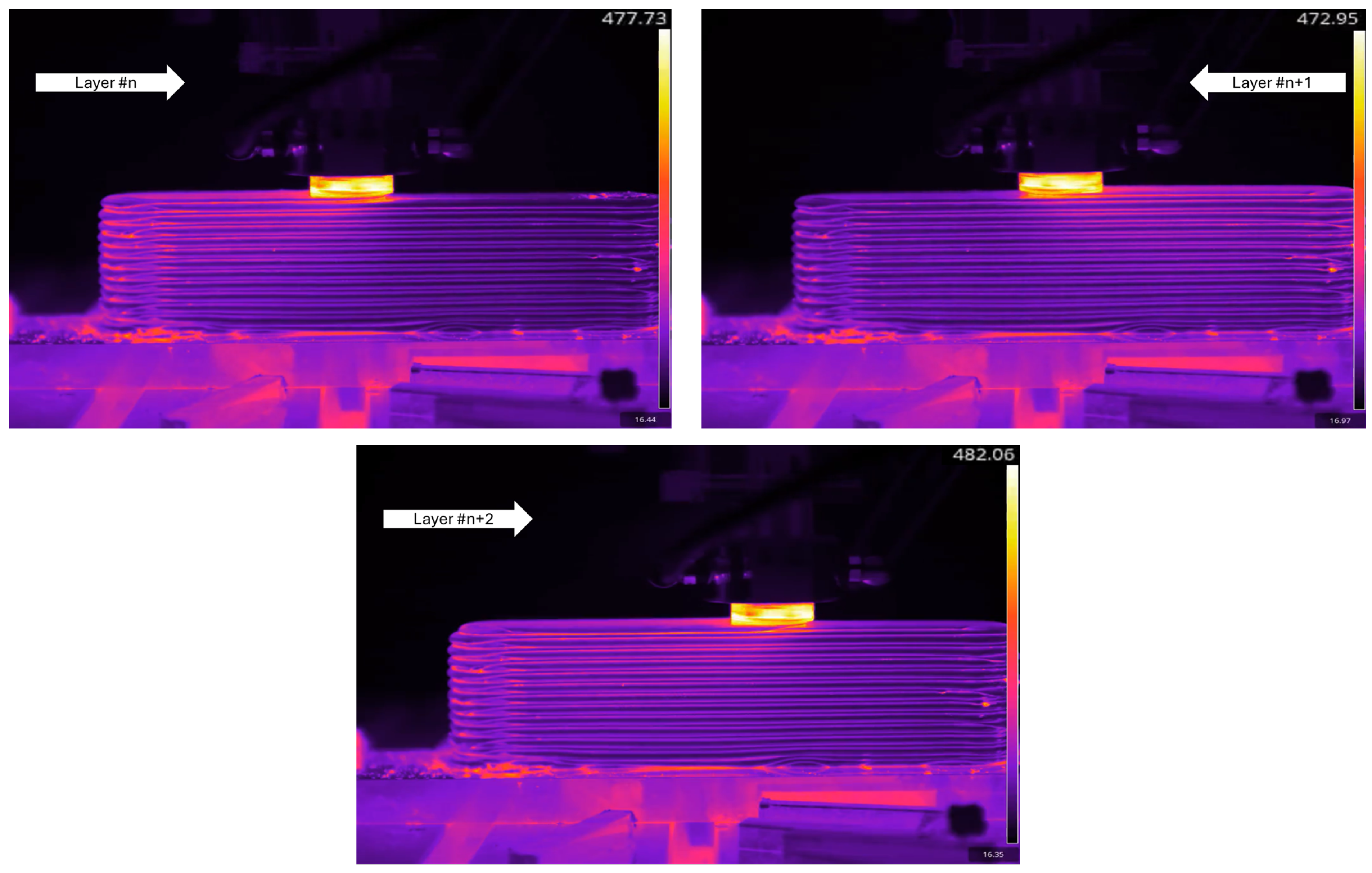




| Parameter | Status | Exp-1 (PID) | Exp-2 (No PID) | Exp-3 (No PID) |
|---|---|---|---|---|
| Spindle Speed (rpm) | Contact | 350 | 350 | 350 |
| Stabilization | 245 | 310 | 245 | |
| Traverse Start | Variable around 437 | 245 | 350 | |
| Traverse Rest | Variable around 245 | 245 | 350 | |
| Actuator Speed (mm/min) | Contact | 20 | 20 | 35 |
| Stabilization | 25 | 25 | 20 | |
| Traverse Start | Variable around 120 | 125 | 120 | |
| Traverse Rest | Variable around 72 | 125 | 100 | |
| Traverse Speed (mm/min) | Contact | 0 | 0 | 0 |
| Stabilization | 0 | 0 | 0 | |
| Traverse Start | Ramping variable around 378 | 195 | 195 | |
| Traverse Rest | Variable around 420 | 420 | 385 |
| Experiment | Location at the Top of the Build | Ring Diameter (mm) | Pitch Distance (µm) |
|---|---|---|---|
| Exp-1 (PID) | 1 | 34.9 ± 2.2 | 1263 ± 205 |
| 2 | 36.9 ± 1.5 | 725 ± 176 | |
| 3 | 35.9 ± 1.3 | 921 ± 66 | |
| Exp-2 (No PID) | 1 | 34.8 ± 1.5 | 1511 ± 43 |
| 2 | 38.4 ± 1.6 | 1547 ± 63 | |
| 3 | 37.0 ± 1.4 | 1504 ± 98 | |
| Exp-3 (No PID) | 1 | 37.7 ± 1.3 | 762 ± 33 |
| 2 | 38.2 ± 1.4 | 753 ± 49 | |
| 3 | 37.0 ± 1.2 | 786 ± 57 |
Disclaimer/Publisher’s Note: The statements, opinions and data contained in all publications are solely those of the individual author(s) and contributor(s) and not of MDPI and/or the editor(s). MDPI and/or the editor(s) disclaim responsibility for any injury to people or property resulting from any ideas, methods, instructions or products referred to in the content. |
© 2025 by the authors. Licensee MDPI, Basel, Switzerland. This article is an open access article distributed under the terms and conditions of the Creative Commons Attribution (CC BY) license (https://creativecommons.org/licenses/by/4.0/).
Share and Cite
Yasa, E.; Poyraz, O.; Do, K.; Molyneux, A.; McManus, J.; Hughes, J. In-Situ Monitoring and Control of Additive Friction Stir Deposition. Materials 2025, 18, 1509. https://doi.org/10.3390/ma18071509
Yasa E, Poyraz O, Do K, Molyneux A, McManus J, Hughes J. In-Situ Monitoring and Control of Additive Friction Stir Deposition. Materials. 2025; 18(7):1509. https://doi.org/10.3390/ma18071509
Chicago/Turabian StyleYasa, Evren, Ozgur Poyraz, Khoa Do, Anthony Molyneux, James McManus, and James Hughes. 2025. "In-Situ Monitoring and Control of Additive Friction Stir Deposition" Materials 18, no. 7: 1509. https://doi.org/10.3390/ma18071509
APA StyleYasa, E., Poyraz, O., Do, K., Molyneux, A., McManus, J., & Hughes, J. (2025). In-Situ Monitoring and Control of Additive Friction Stir Deposition. Materials, 18(7), 1509. https://doi.org/10.3390/ma18071509







